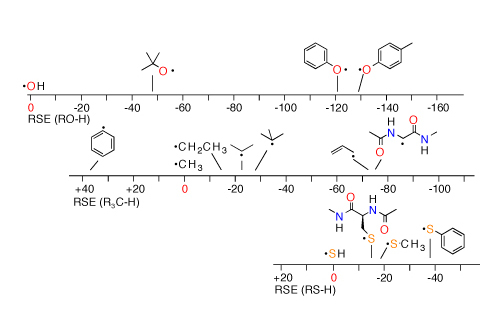Research Area C
Publications 2010
18-Feb-2011

The photoinduced ring-opening reaction of cyclohexadiene (CHD) is a textbook example for electrocyclic reactions. In this paper we report the complete “minimum energy path” of the low-lying region of the conical intersection space reaching from the closed to the open ring side. The general role of conical intersections (CoIns) is to provide the locus for ... READ MORE
18-Feb-2011

Grignard reactants like methylmagnesium chloride are not selective with respect to different carbonyl bonds. We present a theoretical study where shaped laser pulses are utilized to prefer specific bonds in a mixture of more than one carbonyl reactant. A mixture of cyclohexanone and cyclopentanone has been chosen as a representative example. The light pulse is ... READ MORE
18-Feb-2011

A combined experimental and theoretical investigation of photoinduced Z/E isomerizations is presented. Unsubstituted Hemithioindigo is selected as a representative minimal model to unravel the reaction mechanism in the presence of heteroatoms on an atomic level. Time-resolved spectroscopy reveals multiexponential reaction dynamics on the few picoseconds time ... READ MORE
31-Oct-2010

The photoinduced electron-transfer process between a magnesium–porphyrin and a quinone in a model complex has been studied by means of quantum dynamical methods. The microscopic parameters controlling the electron-transfer process have been obtained using ab initio electronic structure calculations. A quantum dynamical simulation for a reduced-dimensionality ... READ MORE
11-Jun-2010

The thermodynamic stability of carbon-centered radicals may be defined in quantitative terms using the hydrogen transfer reaction shown in eqn (a). The stability values obtained in this way for substituted systems may be understood as the stabilizing or destabilizing influence of substituents on the neighboring radical center. This approach can be easily adapted ... READ MORE
14-Apr-2010

We study a monocyclic peptide called cAPB, whose conformations are light switchable due to the covalent integration of an azobenzene dye. Molecular dynamics (MD) simulations using the CHARMM22 force field and its CMAP extension serve us to sample the two distinct conformational ensembles of cAPB, which belong to the cis and trans isomers of the dye, at room ... READ MORE
05-Jan-2010
The first alpha-helix (H1) likely plays an important role in the conversion of the cellular prion protein (PrP^C) into its pathogenic isoform (PrP^Sc). In this conversion, H1 may either have to unfold or may represent a site of intermolecular contact. A recent molecular dynamics simulation suggested that H1 can unfold if it is detached from the protein core ... READ MORE
22-Sep-2009

The thermodynamic stability of radicals involved in enzymatic catalysis has been quantified using a series of theoretical methods. It is found that three of the most often encountered radicals located on the enzyme protein chain (tyrosyl, cysteinyl and glycyl radicals) are of similar stability. This is despite the fact that O–H, S–H and C–H bonds have ... READ MORE
We performed a comparative theoretical study of the relaxation mechanisms of the excited states of uracil and 4-pyrimidinone with the CASSCF, CASPT2, and CC2 ab initio methods. The calculated vertical excitation energies agree with the experimental UV absorption maxima of the two compounds. Three low-lying conical intersections between the S0 and S1 states (one for ... READ MORE


